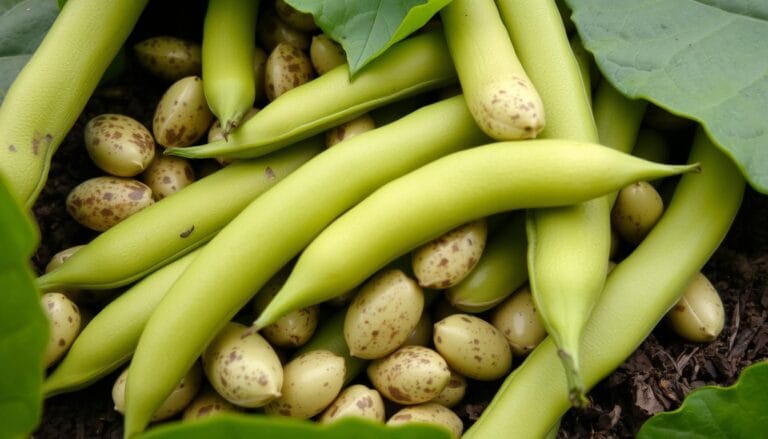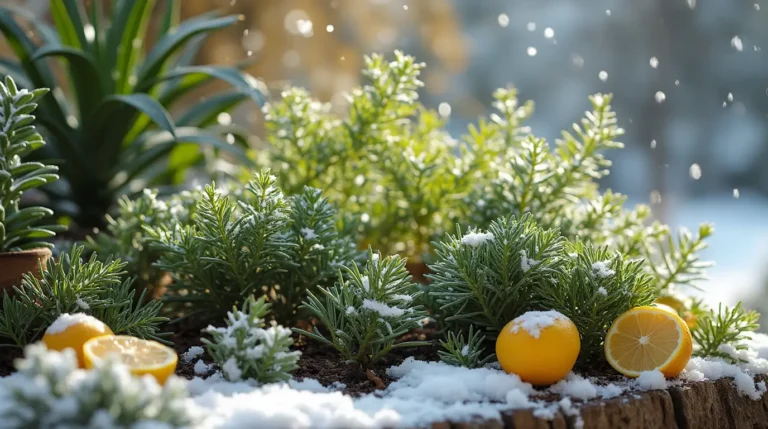Grow Light Success: The Best Winter Plants to Cultivate Indoors

Winter’s chill and shorter days can make us miss greenery and nature. But, you can have a lush indoor oasis even in winter. Grow lights make it possible to create a vibrant space in your home.
I’ve loved indoor gardening for years. Grow lights are amazing because they give plants the light they need, even when it’s dark outside. With the right setup, you can grow many plants, like colorful succulents and fragrant herbs.
We’ll look at the top winter plants for indoor gardens, how grow lights work, and what you need to keep your garden alive. Say goodbye to winter blues and welcome a home full of life and color.
Table of Contents
Understanding Indoor Plant Lighting Essentials
Lighting is key for your houseplants with grow lights to grow well. Knowing about photosynthesis and what light they need helps you make a great place for them to grow.
The Science of Photosynthesis Under Artificial Light
Photosynthesis is how plants make energy from light. Natural sunlight has all the light types plants need. But, artificial lighting for plants must copy sunlight to help plants grow.
Light Spectrum Requirements for Indoor Plants
Indoor plants need light that covers the whole spectrum, from 380 nm to 800 nm. This kind of light, like natural sunlight, helps plants grow from seed to flower.
Daily Light Duration for Optimal Growth
How long plants get light is also important. Most plants need 12 to 16 hours of light a day. Less light can slow growth, and too much can stress them out.
Knowing about photosynthesis and what plants need for light helps you make a great indoor garden. Use houseplants with grow lights and artificial lighting for plants to help them thrive.
| Light Source | Efficiency | Suitability for Indoor Plants |
|---|---|---|
| Incandescent Bulbs | Low (90% heat, 10% light) | Suitable for low-light plants, but not efficient |
| Fluorescent Bulbs | Medium (75% less energy than incandescent) | Second-best choice, less efficient than LEDs |
| LED Grow Lights | High (50% less energy than fluorescent, longer lifespan) | Highly efficient, producing full-spectrum light |
“Understanding the specific light needs of your indoor plants is essential for their healthy growth and development.”
Winter Plants Under Grow Lights: Best Varieties for Indoor Success
Winter is the perfect time to start winter vegetable gardening indoors. Grow lights let you grow a variety of plants at home. You can grow everything from herbs to leafy greens.
Basil is a great herb to grow under grow lights. It smells amazing and tastes great. Succulents, like echeveria, are also good choices. They need little care and do well with artificial light.
- African Violets (Saintpaulia) need a Photosynthetic Photon Flux Density (PPFD) of 70-300 µmol/m²/s. They also need a Daily Light Integral (DLI) of 4-14 mol/m²/d. They do best with 8-16 hours of light.
- Peace Lily (Spathiphyllum) do well with a PPFD of 80-400 µmol/m²/s and a DLI of 4-14 mol/m²/d. They need 12-16 hours of light from LED lights.
- Orchids (Orchidaceae) need different amounts of light. Some need a lot, while others need less. They all need 8-16 hours of light.
Grow lights are great for starting your spring garden early. Plant your favorite vegetables indoors. They will grow well under the light, ready for harvest when it’s warmer.
| Plant Variety | PPFD (μmol/m²/s) | DLI (mol/m²/d) | Photoperiod (hrs) |
|---|---|---|---|
| Anthurium (Anthurium andraeanum) | 80-400 | 4-14 | 12-16 |
| Jasmine (Jasminum) | 90-400 | 5-16 | 12-16 |
| Amaryllis (Hippeastrum) bulbs | 150-300 | 4-14 | 12-16 |
With the right grow lights and care, your indoor garden will thrive all winter. Enjoy the magic of winter vegetable gardening. Let your low-light plant varieties grow under artificial light.
Essential Grow Light Equipment for Indoor Gardening
Winter is the perfect time to grow plants indoors. You’ll need the right grow light systems to keep them healthy. Whether you’re starting seeds or caring for houseplants, the right light is key.
LED vs. Traditional Grow Lights
LED grow lights are now the top choice. They use less energy and last longer. LEDs give plants the light they need for photosynthesis better than old bulbs.
Wattage and Coverage Requirements
The size of your space and plant needs determine the light’s wattage and coverage. Aim for 30-40 watts per square foot. Keep the lights 6-24 inches from your plants, depending on their growth stage.
Timer Systems and Automation Tools
Automating your grow lights makes caring for plants easier. Use timers to set a daily light schedule. This ensures your plants get the right amount of light. Some systems even let you control them with your phone.
“LED grow lamps create full sun conditions for flowers and fruit in close range, making them a game-changer for indoor gardening.”
Choosing the right grow light equipment is crucial. It lets you mimic natural light, even in winter. With the right setup, your indoor garden can thrive all year.
Setting Up Your Indoor Growing Space
Starting a thriving indoor garden requires the right environment. Whether it’s a small herb garden or a grow tent setup, knowing what your space needs is key. This knowledge is essential for your plants to grow well.
First, pick a spot that gets plenty of natural light. If your area doesn’t get enough sunlight, use the right grow lights. Choose energy-saving LED bulbs for full-spectrum light. This kind of light helps plants grow and bloom.
- Position grow lights 6-12 inches above your plants for optimal results.
- Run the lights for 12-14 hours per day to mimic natural daylight conditions.
- Consider using a timer to automate your lighting schedule and ensure consistency.
Don’t forget about temperature and humidity. Keep the temperature between 65-80°F and humidity at 40-60%. Good ventilation is also important. It helps control heat and air around your plants.
Choose high-quality pots or planters with drainage holes. Use a premium potting mix for indoor gardening. This mix gives your plants the nutrients and air they need for healthy roots.
“Successful indoor gardening is all about creating the right environment for your plants to thrive. With the right setup, you can enjoy a bountiful harvest even during the coldest months.”
Finally, think about using shelves or a grow tent setup to save space. This lets you grow more plants in a small area. It’s a great way to use your indoor space wisely.

By carefully setting up your indoor growing space, you’re ready for a successful indoor gardening experience all year.
Temperature and Humidity Control for Indoor Plants
Keeping the right temperature and humidity is key for indoor gardening success. Most plants like a day temperature of 65°F to 75°F (18°C to 24°C). At night, it should not drop below 50°F (10°C). This range is similar to what plants experience outdoors.
Optimal Environmental Conditions
Indoor air is often drier, especially in winter when heaters are on. To keep your plants happy, aim for humidity between 40% and 60%. You can use humidity trays, group plants, or a small humidifier to achieve this.
Managing Heat from Grow Lights
Grow lights are vital for indoor gardens but can make the area hotter. To handle this, choose LED grow lights, which are cooler. Also, use fans to move air and prevent heat from building up.
Humidity Management Techniques
- Use humidity trays filled with pebbles and water to increase moisture levels around your plants
- Group plants together to create a more humid microclimate
- Incorporate a small, energy-efficient humidifier into your indoor growing space
- Mist your plants regularly with a spray bottle to boost humidity
By controlling temperature and humidity, you can make your indoor garden the best place for plants to grow all year. This ensures a successful gardening experience indoors.
Proper Watering Techniques Under Artificial Light
Getting the watering right is key for your indoor plants, especially under grow lights. These lights make plants dry out faster. So, you need to water them more often to meet their needs.
Check the soil moisture regularly. Stick your finger into the soil up to the second knuckle. If it’s dry, it’s time to water. But don’t overdo it, as too much water can harm your plants.
- Use well-draining soil to prevent waterlogging, which can damage your indoor plants.
- Water less often in winter, as plants grow slower then.
- Watch the soil moisture closely, as winter plants under grow lights might need more water.
By being careful with watering and adjusting it for your plants, you can help them grow well under artificial light.
| Plant Variety | Ideal Watering Frequency | Soil Moisture Indicator |
|---|---|---|
| Succulents | Every 1-2 weeks | Allow soil to dry out completely before watering |
| Ferns | 2-3 times per week | Keep soil consistently moist, but not waterlogged |
| Herbs | Every 3-5 days | Water when the top inch of soil is dry |
Follow these indoor plant care tips and adjust your watering for your winter plants under grow lights. You’ll have healthy, thriving plants all year.
Common Growing Challenges and Solutions
Growing plants indoors with grow light systems can be tricky. But, with the right knowledge and strategies, you can overcome these challenges. This way, you can enjoy a thriving indoor garden. Let’s look at some common issues and their solutions.
Preventing Leggy Growth
Indoor plants often grow leggy, with long, spindly stems. This happens when they don’t get enough light. To stop this, make sure your indoor gardening setup has enough light. Place your grow light systems about 12-18 inches above the plants. This helps them grow strong and compact.
Managing Light Distance
As plants grow, they need more light. Watch them closely and raise your grow lights as needed. Keep the distance between 12-18 inches. This prevents light burn and ensures your plants get the right light.
Addressing Light Burn Issues
Light burn is another common problem. It makes leaves yellow, curl, or change color from too much light. To fix this, rotate your plants often. This ensures they get light evenly. If the problem continues, try reducing the grow light systems intensity or time.
By knowing these common challenges and their solutions, you can create a thriving indoor garden. Enjoy the rewards of successful indoor gardening with your grow light systems.
Maintaining Healthy Plant Growth Year-Round
To keep your indoor plants healthy all year, you need a good plan. Make a routine for pruning, fertilizing, and adjusting care with the seasons. This is true even with artificial lighting.
Watch your plants for stress or disease signs. Clean your grow lights often to keep them working well. Try to add natural light to help your plants stay healthy.
Change your plants and soil to avoid nutrient loss. This keeps the soil fresh and adds variety to your garden.
Seasonal Adjustments for Year-Round Indoor Plant Care
- Adjust light duration and spectrum to match the natural seasonal changes
- Modify watering schedules to account for changes in temperature and humidity
- Prune and trim plants to encourage bushier growth and prevent leggy, stretched appearances
- Evaluate and replenish soil nutrients with a balanced, organic fertilizer
Keep a steady yet flexible care plan for indoor year-round gardening. This way, your plants will stay healthy and beautiful all year.
| Lighting Requirements | Watering Needs | Fertilization Schedule |
|---|---|---|
|
|
|

“The key to successful indoor gardening is adapting your care regimen to the unique needs of each plant, no matter the season.”
Conclusion
Growing plants indoors with grow lights opens up a world of possibilities. You can grow a variety of plants all year round. By learning about lighting, temperature, humidity, and watering, you can create thriving gardens indoors.
These gardens can bring beauty and benefits of nature into your home or office. Whether you want fresh produce, cleaner air, or the joy of caring for plants, the right setup can make it happen. This is true even in the coldest winter months.
With the right grow lights and care, you can enjoy the rewards of winter plants indoors. You can have lush foliage and vibrant blooms. Indoor gardening lets you connect with nature and create your own oasis, any time of the year.
By following this guide, you can unlock the full potential of indoor gardening. Improve your green thumb and enjoy the rewards of growing plants under artificial lights. Even when it’s snowy outside, you can still grow plants indoors.
Nurturing winter plants indoors is a journey of resilience and creativity. It’s a way to appreciate the natural world even more.
FAQ
What are the benefits of growing plants with grow lights during the winter?
What types of grow lights are available for indoor gardening?
What light spectrum and duration do plants need for optimal growth under artificial lighting?
What are some of the best plants to grow indoors with grow lights during the winter?
How do I determine the wattage and coverage requirements for my indoor grow lights?
What environmental factors should I consider when setting up an indoor winter garden with grow lights?
How do I properly water and care for my plants under grow lights during the winter?
What common challenges might I face when growing plants under grow lights, and how can I address them?
Source Links
- Do I need a grow light for my houseplants in winter? Our experts weigh in – https://www.homesandgardens.com/gardens/grow-lights-for-houseplants
- Top 10 Flowers to Grow Indoors with LED Grow Lights – https://activegrowled.com/pages/top-10-flowers-to-grow-indoors-with-led-grow-lights?srsltid=AfmBOorl1IS_jXu1QPVr9hv6o1Srb23qaOhG4-JhOCAx_Q_4C3Qme2BS
- Growing Vegetables Indoors 🥗 Under LED Grow Lights – https://www.gardeners.com/how-to/growing-vegetables-indoors/9196.html?srsltid=AfmBOoqhumXEe3EGwiYrIsF-YoAwaA7X735ryPsE4GKIxbCXAoLJ1G2O
- How to Choose the Best Grow Lights for Plants at Every Stage – https://www.bhg.com/gardening/houseplants/care/choosing-plant-grow-lights/
- A Beginner’s Guide to Using Grow Lights for Indoor Plants – https://blog.acmetools.com/how-to-use-grow-lights-acme-tools/
- Preparing Your Indoor Garden In Winter – https://growace.com/blogs/learning-center/preparing-an-indoor-garden-during-winter-lets-find-out?srsltid=AfmBOorL8nssGxHC4dGKOdYlk47L0Z9Kdgdnn4diLnzmIg-6AT9JFI1y
- Top 10 Flowers to Grow Indoors with LED Grow Lights – https://activegrowled.com/pages/top-10-flowers-to-grow-indoors-with-led-grow-lights?srsltid=AfmBOoretC9ejAHR1IXpQjxgs7V-KiFZRLPWEUG2RxZL5zfi2uhKKyXo
- Indoor Winter Gardening for Beginners | Platt Hill Nursery – https://platthillnursery.com/indoor-winter-gardening-for-beginners/?srsltid=AfmBOopY44tne1aUEycw3MxjMFgvZHfMdIM-3TCBcKOKZ5OKzRq3M8ju
- You Must Sow These in January – https://www.growveg.com/guides/you-must-sow-these-in-january/
- 10 Grow Lights We Tested For Keeping Houseplants and Seedlings Happy All Winter – https://www.thespruce.com/best-grow-lights-4158720
- Gardening Under Grow Lights | Gardener’s Supply – https://www.gardeners.com/how-to/gardening-under-lights/5080.html?srsltid=AfmBOormk9lBG0dguXJqYN16IayO7DR3071OeTJAlm9lpjvXoIQ36LGZ
- Growing Vegetables Indoors 🥗 Under LED Grow Lights – https://www.gardeners.com/how-to/growing-vegetables-indoors/9196.html?srsltid=AfmBOoqHs83SFMdn3k2f7NLkWirqCFAJlGr_llcDnAQTRIH0oONM1Orf
- Here’s How to Use Grow Lights to Keep Your Indoor Garden Thriving – https://www.bhg.com/gardening/houseplants/care/indoor-plant-lights/
- Gardening Under Grow Lights | Gardener’s Supply – https://www.gardeners.com/how-to/gardening-under-lights/5080.html?srsltid=AfmBOorhQTpJ7EgIYfGZCytN8XcxW-CTaDLGajAeBqyT76VCf98YRHEN
- Growing Vegetables Indoors 🥗 Under LED Grow Lights – https://www.gardeners.com/how-to/growing-vegetables-indoors/9196.html?srsltid=AfmBOoqesyrGjtjn2TgxGSS56xrzfZKv5qyeB5VhDScS4HnTCAwD4a7s
- Preparing Your Indoor Garden In Winter – https://growace.com/blogs/learning-center/preparing-an-indoor-garden-during-winter-lets-find-out?srsltid=AfmBOorOxUNy0MQZnL0TJ52x4A4CZAFNknBCT0rXAjUKSCUXvUjUFEdN
- How to Care for Indoor Plants: A Complete Guide – https://plantorbit.com/blogs/news/how-to-care-for-indoor-plants-a-complete-guide?srsltid=AfmBOopMRwbiJS5nHOjGM-tbjEunbqp5JFaWrq4YKkuWvvC21SkV-ZX9
- Gardening Under Grow Lights | Gardener’s Supply – https://www.gardeners.com/how-to/gardening-under-lights/5080.html?srsltid=AfmBOoqVrF7RrmwUI7GfvbYIEONPzz4Lgzmc1GkEP8g9hCXn3yUCld6T
- Preparing Your Indoor Garden In Winter – https://growace.com/blogs/learning-center/preparing-an-indoor-garden-during-winter-lets-find-out?srsltid=AfmBOoqKW_oER4K0vZNuY-E452M7KskHGTHCYgVCYKE7DJ6Xw91r5eu6
- Growing Vegetables Indoors 🥗 Under LED Grow Lights – https://www.gardeners.com/how-to/growing-vegetables-indoors/9196.html?srsltid=AfmBOopamhrs4wc7K4pkXp6-cmNjYVLg2KjMJrwdgbGx9e9OvrZkNdds
- 5 Common Indoor Gardening Challenges and Their Solutions – https://www.allthatgrows.in/blogs/posts/indoor-gardening-challenges-solutions?srsltid=AfmBOop6fZKkKOFaePFH5S3ZskSOqelCkNAfIRJgab0egZiuzeDwJ0Tv
- Preparing Your Indoor Garden In Winter – https://growace.com/blogs/learning-center/preparing-an-indoor-garden-during-winter-lets-find-out?srsltid=AfmBOoqXOrSah9sz36wYHg89-DyoOqjbNkz3v7KrKp2tdSoJXym3XSAD
- Gardening Under Grow Lights | Gardener’s Supply – https://www.gardeners.com/how-to/gardening-under-lights/5080.html?srsltid=AfmBOoqxRpcfN9UJp7i1lwFGmBZfmK8BUlvPwbZn-dRI9l4VtGAzYjV0
- Growing Vegetables Indoors 🥗 Under LED Grow Lights – https://www.gardeners.com/how-to/growing-vegetables-indoors/9196.html?srsltid=AfmBOorr6SU2mkvM475Tu2b032JAw0nfUIQPbXnnIPs8QB2tsVZ7c73U
- Growing With Grow Lights – https://gathera.com/blogs/how-to/growing-with-grow-lights?srsltid=AfmBOoqeJBxQgI1iZDyZ5waJetkxuffr_B3GWFKjjkcgAhzrdESqrteA
- 10+ Ways to Keep Plants Warm in Winter – https://www.spider-farmer.com/blog/keep-plants-warm-in-winter/
- Winter Houseplant Care Guide — West Seattle Nursery – https://www.westseattlenursery.com/blog/winter-houseplant-guide
There are no reviews yet. Be the first one to write one.






